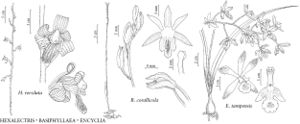Difference between revisions of "Hexalectris revoluta"
Bot. Mus. Leafl. 10: 19, fig. 2. 1941.
FNA>Volume Importer |
FNA>Volume Importer |
||
| Line 25: | Line 25: | ||
|distribution=Ariz.;Tex.;ne Mexico. | |distribution=Ariz.;Tex.;ne Mexico. | ||
|discussion=<p>Of conservation concern.</p><!-- | |discussion=<p>Of conservation concern.</p><!-- | ||
| − | --><p>In Arizona Hexalectris revoluta grows in Cochise and Pima counties; in Texas, in the Guadalupe and Chisos mountains.</p><!-- | + | --><p>In Arizona <i>Hexalectris revoluta</i> grows in Cochise and Pima counties; in Texas, in the Guadalupe and Chisos mountains.</p><!-- |
| − | --><p>Hexalectris revoluta has a less densely flowered raceme than H. nitida, and more revolute sepals and petals, and more deeply lobed labellum than H. spicata, both species with which it is occasionally confused. The plants are occasionally associated with Acacia, Juglans, and Prosopis in Arizona (R. A. Coleman).</p> | + | --><p><i>Hexalectris revoluta</i> has a less densely flowered raceme than <i>H. nitida</i>, and more revolute sepals and petals, and more deeply lobed labellum than <i>H. spicata</i>, both species with which it is occasionally confused. The plants are occasionally associated with Acacia, <i>Juglans</i>, and Prosopis in Arizona (R. A. Coleman).</p> |
|tables= | |tables= | ||
|references= | |references= | ||
| Line 50: | Line 50: | ||
|publication year=1941 | |publication year=1941 | ||
|special status= | |special status= | ||
| − | |source xml=https://jpend@bitbucket.org/aafc-mbb/fna-data-curation.git/src/ | + | |source xml=https://jpend@bitbucket.org/aafc-mbb/fna-data-curation.git/src/8f726806613d60c220dc4493de13607dd3150896/coarse_grained_fna_xml/V26/V26_1238.xml |
|subfamily=Orchidaceae subfam. Epidendroideae | |subfamily=Orchidaceae subfam. Epidendroideae | ||
|tribe=Orchidaceae tribe Arethuseae | |tribe=Orchidaceae tribe Arethuseae | ||
Revision as of 16:41, 18 September 2019
Stems tan, pale pink, to pale brown-purple, 30–50 cm; sheathing bracts 3–5. Inflorescences: floral bracts lanceolate to ovate, 5–15 × 3–4 mm. Flowers 5–15(–20), pedicellate, chasmogamous; sepals and petals strongly recurved, tan to pinkish brown; dorsal sepal oblong-elliptic to lanceolate, 15–25 × 3–8 mm; lateral sepals obliquely elliptic to elliptic-lanceolate, 15–22 × 3–8 mm; petals narrowly elliptic to obovate or oblanceolate, slightly falcate, 15–19 × 4.5–7.5 mm; lip broadly elliptic, deeply 3-lobed, 13–18 × 9–13 mm, fissure between lobes more than 3 mm deep, middle lobe white with purple, pale yellow near base, obovate-cuneate, apex truncate to retuse, lateral lobes incurved, oblong, obtuse, 1/2–2/3 length of middle lobe; lamellae 3, 5, or 7, white to yellow, obscure; column purple abaxially, white-purple adaxially, 9–15 mm; anther yellow. Capsules 20 × 5 mm.
Phenology: Flowering May–Aug.
Habitat: Oak-juniper-pinyon pine woodlands in leaf litter and humus, occasionally in rocky, open terrain
Elevation: 1000–1600 m
Distribution

Ariz., Tex., ne Mexico.
Discussion
Of conservation concern.
In Arizona Hexalectris revoluta grows in Cochise and Pima counties; in Texas, in the Guadalupe and Chisos mountains.
Hexalectris revoluta has a less densely flowered raceme than H. nitida, and more revolute sepals and petals, and more deeply lobed labellum than H. spicata, both species with which it is occasionally confused. The plants are occasionally associated with Acacia, Juglans, and Prosopis in Arizona (R. A. Coleman).
Selected References
None.
